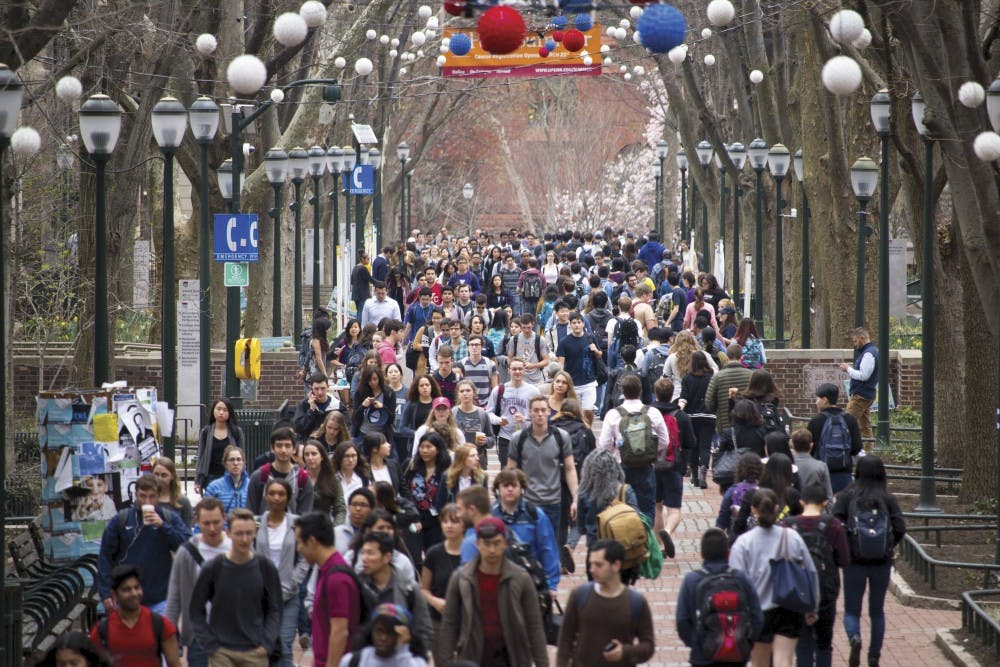
Penn Association for Gender Equity and the Civic House took students on a walking tour through West Philadelphia to experience gentrification first-hand.
Credit: Julio Sosa | Senior PhotographerIt is easy to settle in the comfort of Locust Walk, but some lessons are better learned off campus.
The Penn Association for Gender Equity and the Civic House hosted a walking tour through West Philadelphia on Friday, as well as a follow-up discussion. Attendees ventured down Baltimore Avenue and Lancaster Avenue to witness gentrification in West Philadelphia first-hand.
Gentrification is defined as the renovation of deteriorated urban neighborhoods by the influx of more affluent residents. Communities’ property values increase as a result, but gentrification often displaces low-income families and small businesses. Gentrification explains the jarring juxtaposition between upscale stores catered to college kids and hollowed local shops and closed schools throughout West Philadelphia.
“There’s not a lot of understanding on how West Philadelphia and Penn are in many ways interdependent. Actions taken by the University impact the West Philadelphia community,” PAGE Education Chair and College senior Julia Slater said.
The walking tour sought to examine Philadelphia’s gentrification in a hands-on and direct experience.
“With only discussion, we still don’t know West Philadelphia’s rich history and community, and how it can take care of itself,” PAGE Constituent Affairs Chair and College sophomore Jamie Ye said.
With this goal in mind, PAGE supplied guided questions during the walk — asking participants to note green spaces, health services schools and more. The tour groups convened in the Paul Robeson House, the home of an influential African-American figure who grew up in West Philadelphia.
Students discussed the walk and organized a timeline, outlining the origins of West Philadelphia and Penn’s contribution to its gentrification. Subsequent discussion touched on how Penn students themselves often benefit from West Philadelphia’s gentrification, and members said staying informed about the issue and spreading it is critical.
“You don’t have to go out on long walks really far off campus,” Ye said. “But you can attend events like this and do your own research about what is the history of how Penn got here, and how we obtained this land.” Professors and community experts — including a robust Urban Studies program — can help students educate themselves further, she added.
PAGE also noted intersections between gender issues and gentrification issues.
“I think gentrification is tied to women’s issues in that gentrification often negatively affects the community members who were originally there, linking to things like race and police involvement in communities, especially with American drug policy. So who are the people being criminalized for these things, and who’s left in the communities? It’s often women left at the households of these communities,” Ye said.
Megan Yan, PAGE chair and College and Wharton senior who is also the former business manager of The Daily Pennsylvanian, emphasized that an event doesn’t have to be solely focused on women to be within the organization’s interests.
“These movements don’t exist in isolation; they have to tie together,” she said. “Our mission and the work that we do can’t just be about only gender issues, but also has to tie into these others that very much impact gender. There must be a coalition in social justice movements.”
The Daily Pennsylvanian is an independent, student-run newspaper. Please consider making a donation to support the coverage that shapes the University. Your generosity ensures a future of strong journalism at Penn.
DonatePlease note All comments are eligible for publication in The Daily Pennsylvanian.




